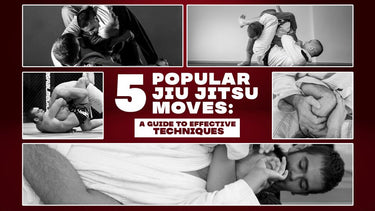
Introduction
I remember my first day on the mats like it was yesterday - getting smashed by a 140-pound blue belt while I, a former college athlete, couldn't understand what was happening. That's the beauty of Brazilian Jiu-Jitsu (BJJ): it's a game of human chess where technique trumps strength. After 15 years of training and countless hours studying jiu jitsu moves, I've found that certain techniques consistently prove their worth in both competition and rolling. Today, I'm breaking down five powerful BJJ moves that have become cornerstones of my game.

1. The Triangle Choke: The Art of the Three-Point Attack
Picture this: It's 2019, and I'm competing at Masters Worlds. My opponent shoots a sloppy double leg, and before he knows it, he's caught in my triangle. The beauty of this submission isn't just in the choke - it's in the setup and control.
Advantages:
- Works like a charm against bigger opponents (trust me, I've tapped 250+ pounders with this)
- Can transition into omoplatas or armbars if they defend
- Excellent for guards of all lengths (yes, even you stocky players)
Disadvantages:
- Watch out for the stack defense (learned this the hard way)
- Can be energy-intensive if not locked properly
- Requires good hip mobility

During my early days as a white belt, my coach once said, "If you can't hit an armbar from every position, you don't really know armbars." These essential BJJ moves became my obsession, and now they're my bread and butter.
Advantages:
- High-percentage finish from guard, mount, or back
- Universal across gi and no-gi
- Creates beautiful combinations with other attacks
Disadvantages:
- Timing is crucial (especially against explosive opponents)
- Can lose position if executed poorly
- Requires solid hip control

Let me tell you about the time I discovered the true power of the Kimura. I was a purple belt getting worked by a wrestling-based black belt until I caught this grip. The Kimura isn't just a submission - it's a position and a pathway to other jiu jitsu moves.
Advantages:
- Works as both control and submission
- Excellent against stronger opponents when used technically
- Creates multiple attack chains
Disadvantages:
- Can be defended by flexible opponents
- Grip-intensive in the gi
- Requires careful pressure application

4. The Rear Naked Choke: The Great Equalizer
In my gym, we have a saying: "Position before submission, but the RNC is always there." This fundamental technique remains one of the highest percentage BJJ moves in both sport and self-defense.
Advantages:
- Nearly unstoppable when properly locked
- Works regardless of size difference
- Minimal energy expenditure
Disadvantages:
- Getting to the back is the hard part
- Hand fighting can be exhausting
- Requires proper head positioning

My first submission in competition was a guillotine. Years later, it's still my go-to counter against takedown attempts and one of the most reliable jiu jitsu moves in my arsenal.
Advantages:
- Perfect counter to wrestling-style attacks
- Works well in transition
- Powerful from both top and bottom
Disadvantages:
- Arm fatigue is real
- Can be countered by experienced players
- Position can be compromised if missed
How to Memorize BJJ Moves: A Champion's Approach
I still remember struggling to remember basic sweeps as a white belt. Now, after coaching hundreds of students and winning multiple tournaments, I've discovered that mastering jiu jitsu moves isn't about raw memory - it's about building connections. Here's my battle-tested approach:
- Mind Mapping: Think of BJJ moves like a spider web. That armbar from guard? It connects to the triangle, which links to the omoplata. When drilling one technique, I always show my students its "cousins." This mental framework makes techniques stick.
- Deliberate Practice: At our gym, we call it the "Mount Month" or "Guard Quarter" - focusing on one position until it becomes second nature. Pick your position, then dive deep for at least 30 days.
- Flow Training: Start at 50% speed, like you're moving through honey. I learned this from my old professor: "Speed is the enemy of perfection." Once you can flow smoothly, gradually increase the pace.
- Video Study: The best competitors all do it. Record your rolls (I still do), and watch competition footage of your favorite athletes. Focus on one player who matches your body type and style.
The Power of Drilling: Beyond the Basics
There's a reason why we start every class with specific drills. As my first coach used to say, "Drillers make killers, but smart drillers become champions." Here's what proper drilling does:
- Builds muscle memory so clean you could pull off moves in your sleep
- Develops that sixth sense for timing and weight distribution
- Programs your nervous system for faster reactions
- Makes techniques feel as natural as walking
Mat-Tested Tips for Faster Learning
After years of both learning and teaching BJJ moves, here's what really works:
- Find your body type's game: As a lanky practitioner, I focused on spider guard and triangles. Your body is unique - let it guide your style.
- Seek out higher belts who'll push you (respectfully). The best lessons often come after getting tapped.
- Journal your progress: Quick notes after class about key details. Trust me, you'll thank yourself later.
- Master defense first: You can't play offense if you're always surviving. Start each roll focusing purely on defense.
Conclusion
These fundamental BJJ moves are more than just techniques - they're keys to understanding the deeper aspects of jiu-jitsu. Whether you're a white belt looking to build a solid foundation or a higher belt refining your game, mastering these movements will elevate your jiu-jitsu to new heights. Remember, the journey of learning never ends - that's what makes our art so beautiful. Now get out there and start rolling!
